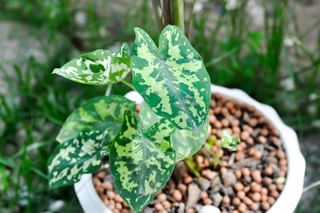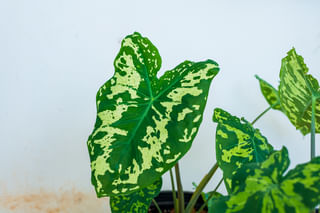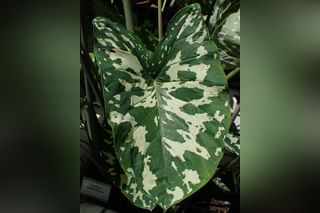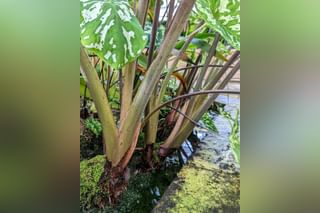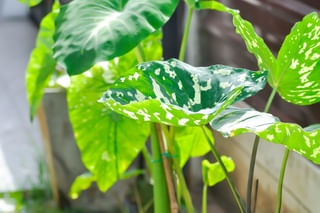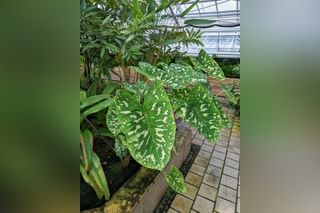How to take care of a Caladium Praetermissum (Hilo Beauty)
In this plant care guide, we're looking at how you can take care of your Caladium Praetermissum, also known as the Hilo Beauty. We'll cover things like watering, proper sunlight, fertilizer, soil, and even propagation. Find out how to take care of your Hilo Beauty!
Are you looking for a gorgeous plant with striking color patterns? The Caladium Praetermissum, also known as the Hilo Beauty, might be the perfect choice for your next plant! This amazing-looking plant from the Islands of Hawaii is a tropical plant that loves humidity, warmth, and bright indirect sunlight! It is an easy-to-care-for plant and with some basic instructions, you can keep your Hilo Beauty looking great for years to come.
In this plant care guide, we're going to look at how you can take care of this tropical plant in your home. We will look at every part of taking care of the Hilo Beauty, including how and when you should water it, how much sunlight it needs, but also things that you might not need right away, like repotting your Hilo Beauty and how you can go about propagating this stunning plant.
These are the topics we're going to look at in this plant care guide:
Let's get started and let's learn how we can help the Caladium Hilo Beauty thrive in your house!
How often should I water my Caladium Hilo Beauty?
The most important part of taking care of your plants is to water them properly. Every plant is different and proper watering is important to keeping your Caladium Hilo Beauty healthy and thriving. If you water it too little or too much, this can damage the plant, and in extreme cases can even kill it.
The best way to find out if you need to water your Hilo Beauty is by keeping an eye on the soil.
The Hilo beauty prefers moist soil but doesn't like to sit in soggy soil. To make sure you're watering your plant properly, you'll need to check the soil every few days. You'll need to check whether the top of the soil is dry before it's time to water your plant again. You can do this by sticking your finger or a skewer in the soil. If the top 5 cm (2 inches) of the soil is dry, you can water your plant. If not, wait a few more days and try again.
It's difficult to say exactly how often you should water your Hilo Beauty, because it depends on a lot of things, like the current season, the climate where you live, and how warm your home is. That's why it's important to keep checking the soil. On average, you'll probably water your plant once per week. Again, make sure to check the soil before watering your plant to prevent overwatering.
Signs of too much or too little water
Sometimes, you might have watered your Hilo beauty a little too much or too little. But how do you know what's wrong with your plant? The easiest way is to look out for signs your plant isn't happy. If a Caladium Hilo Beauty is underwatered it will show signs of wilting and drooping leaves as well as yellowing foliage and brown tips. If it's overwatered, there may be root rot present, stunted growth as well as discolored leaves that are wilting and turning yellowish-green in color.
If you notice any of these symptoms, make sure to adjust your watering schedule to give your plant the best chance to recover.
What kind of light does the Caladium Hilo Beauty need?
The Colocasia Hilo Beauty is a tropical plant that thrives in bright, indirect light. It prefers a lot of light and ideally is in a spot that receives bright, indirect light all day. The best way to provide the right amount of light for your Caladium Hilo Beauty is to place it near a bright window or outside in partial shade.
If you have access to a screened-in area that gets lots of bright light, this would be ideal for the plant. If you don't have access to that kind of location, try placing the plant on an east-facing windowsill where it will still get plenty of indirect light but won't suffer from too much direct light.
Signs of too much or too little sunlight
If your Hilo Beauty gets too much direct sunlight it will begin to suffer from sunburned leaves. This looks like yellow and brown spots on the leaves. On the other hand, you Hilo Beauty can survive in a spot that gets low to medium light. It won't grow as quickly and its leaves will slightly fade to an even green color, losing its beautiful patterns.
To keep your Hilo Beauty happiest and to give it the best chance at thriving, make sure you place it somewhere where it has access to plenty of bright and indirect light throughout the day.
What is the ideal temperature for the Caladium Hilo Beauty?
As we've discovered in the introduction, the Hilo Beauty is native to Hawaii, so it loves the tropical weather and the higher temperatures. The ideal temperature range for the Hilo Beauty is between 16℃ and 32℃ (60℉ - 90℉). The Hilo Beauty likes warm temperatures, but it's important to keep an eye on your plant, especially during the summer, as temperatures above 32℃ (90℉) can cause damage and even kill the plant. Temperatures below about 16℃ (60℉) will also cause the leaves to become limp and discolored, and may eventually lead to the death of the plant.
This temperature range is very similar to the temperature in most houses throughout the whole year, so unless your house has large temperature shifts throughout the day or year, you don't have to take any extra steps to keep this plant happy in your home.
How much humidity does my Caladium Hilo Beauty need?
Krzysztof Ziarnek, Kenraiz, CC BY-SA 4.0, via Wikimedia Commons
A lot of houses are already a great growing environment to help houseplants thrive. Yes, you did read that right. However, some plants, like the Hilo Beauty, just need a little more humidity than your house might already have. The Caladium Hilo Beauty loves high humidity. It's best if the air around it is between 50 and 80 percent humidity.
If you don't have a spot with that much humidity, don't worry! There are plenty of great ways to increase the humidity around your plant. You can mist its leaves with a spray bottle filled with water regularly (once per day), or use a room humidifier to add more moisture to the air. But one of my favorite ways to raise the humidity for a plant is to place the potted Caladium Hilo Beauty in a shallow tray of pebbles, with water added to it. The pebbles prevent the pot from sitting in the water, so you're not overwatering your plant.
You can also place multiple plants together, as these plants will raise the humidity around them, so they all benefit from the extra humidity. Additionally, keeping your plants away from vents or open windows will make sure they don't get too dry due to cold drafts.
As you can see, even if your house is very dry, you can still create the perfect growing environments to keep your Hilo Beauty happy.
What type of soil is best to use when planting a Caladium Hilo Beauty?
If you've ever taken care of tropical heavy feeders, like an Alocasia Zebrina or a Monstera, you'll know that these plants thrive in soil that retains moisture for several days, but also drains the excess moisture away quickly. This keeps the soil moist, but not soggy. These types of plants also love soil that's very rich in organic matter and nutrients, because they need all of these nutrients to stay healthy while they grow.
The perfect mix
The ideal soil for your Hilo Beauty is a moist, well-drained potting soil that's rich in organic matter and nutrients. When you're preparing the soil for planting, it's important to make sure it's light, fluffy, and free from any clumps or chunks. Mix in some peat moss and perlite as this will allow water to drain quickly yet still retain the moisture your plant needs to stay happy. This mixture will also absorb a lot of the fertilizer, to keep it readily available for the plant's roots to absorb.
The mixture of general potting soil, peat moss, and perlite prevents the soil from compacting over time. This is very common if you're growing a plant that needs a lot of moisture to stay healthy. If the soil compacts too much over time, it won't drain the moisture as well and can also prevent oxygen from reaching your plant's roots. This will develop root rot quickly, so you're helping your plant stay healthy by adding the peat moss and perlite.
Now that we've covered the day-to-day care of the Hilo Beauty, let's dig a little deeper into things like fertilization, repotting your plant, and propagation!
Is fertilization necessary for the Caladium Hilo Beauty?
Fertilization is very important for a Caladium Hilo Beauty as it grows quickly and can become quite large. Because of this growth, it's a "heavy feeder". For these heavy feeders, fertilizing regularly is very important for them to stay healthy.
The best way to fertilize the Hilo Beauty is to fertilize it once every two weeks in the growing season, spring and summer, with an all-purpose liquid fertilizer like a 10-10-10 or 20-20-20. Don't fertilize the Hilo Beauty in the winter, as it won't absorb the fertilizer, so you can very easily over-fertilize your plant and accidentally cause a chemical burn on the plant's roots.
Apply the fertilizer directly to the soil
If you're not using a liquid fertilizer, make sure the soil is slightly moist before you apply the fertilizer. Apply the fertilizer around the base of the plant, avoiding contact with its leaves or stems. After application, gently water your plant so the fertilizer can be taken up by the roots of your Hilo Beauty. If you're using a liquid fertilizer, simply add it to the water when you water your plant and your job is done.
Be sure to follow label instructions carefully when using any type of fertilizer. Too much fertilizer will damage your plants, so always use it according to the instructions on the label.
Repotting a Caladium Hilo Beauty
Repotting is important for all plants, some just take a little longer to outgrow their pots. On average, you'll have to repot your Caladium once every 1-2 years. Around this time, they'll have outgrown their pots and it's time for a bigger one. The best time of year is early spring, right before growth starts.
Signs it's time to repot
You'll know it's time to repot your Caladium, when you notice these signs:
- Roots are growing through the drainage holes.
- The plant looks top-heavy or crowded.
- Soil seems compacted or waterlogged.
If you notice any of these signs, make sure to check if the plant is rootbound, but carefully pulling the plant from the pot and checking the roots. If they've started to circle the bottom of the pot, it's time to repot the plant.
Steps to repot
Here's how you repot your Caladium:
- Find a pot that is 1-2 inches larger in diameter than the current one and has a drainage hole
- Find or create a well-draining potting mix
- Carefully take the plant out of its current pot, being careful not to damage the roots. You might have to carefully squeeze the pot to loose the roots before pulling it out.
- While you've got the plant out of its pot, check for any signs of root rot or disease and trim off any unhealthy roots.
- Last but not least, place the plant in the new pot, fill it with fresh soil, and water it thoroughly.
That's really all there is to it!
What to do if you plant looks sad after repotting
After you've repotted your Caladium, it could start to look a little sad. This means your plant is stressed, because plants generally don't like to be handled. This can be scary, especially if you haven't repotted plants before. Don't worry, you didn't do anything wrong!
Here's what you do. You leave your plant alone for 2 weeks. Your plant needs time to adjust to it's new pot and the fresh soil. All you have to do is water it when the soil is dry, not move the plant around, and keep a close eye on your plant to check for pests. A stressed plant is a prime target for pests, so closely check your plant every few days to catch any issues early on.
Pruning or trimming Caladium Hilo Beauty
You should prune or trim your Caladium Hilo Beauty to keep it healthy and encourage new growth. With pruning, I mean removing any dead or damaged leaves, as this improves keeps pests away and also makes the plant look better.
To prune your Caladium Hilo Beauty, find any yellowing, brown, or dead leaves. Use clean, sharp scissors or pruning shears to make a clean cut at the base of the leaf stem.
Always make sure your tools are sterilized to prevent spreading pests or diseases to other plants.
If you've got any leggy growth and want to make the plant look a little more compact, you can trim this leggy growth as well. Keep in mind, never trim more than 1/3 of your plant, as it'll need time to recover and pruning too much can make that difficult.
How do I propagate a Caladium Hilo Beauty?
You've already learned that the Hilo Beauty is a fast-growing houseplant that grows quite large, so at some point, you might find yourself wanting to propagate this plant. You might want to grow more of the plant or share some cuttings with your friends and family! Luckily, propagating a Caladium Hilo Beauty is a simple process that anyone can do!
You can propagate the plant by using division or by propagating from seed.
If you want to start propagating your Hilo Beauty, make sure to wait for spring or summer. Your plants will recover from propagation much more quickly during this time of year.
Propagation through division
To divide the Caladium Hilo Beauty, you should use a sharp and sterile knife to cut through the root system of the plant. Cut into sections, making sure each section has at least one growing bud, also known as an eye. Replant each division in separate pots filled with soil and water, then place them in a warm area with indirect sunlight.
Growing new plants through seeds
If you're looking to propagate from seed, purchase new organic seeds from your local gardening shop. Soak the seeds overnight in warm water before planting them in small containers filled with potting soil. Make sure to keep the soil moist but not wet until germination occurs, usually after 2-3 weeks.
You should now have all the tools to successfully grow new Caladiums at home and share them with your friends and family!
Can I grow a Caladium Hilo Beauty outdoors in a cold climate?
Many plant owners wonder if you can move your plant outside, especially in the summer. If you live in a tropical climate, much like Hawaii, moving your plant outside is fine. However, if you live in a colder climate, this might not be so easy. But there is still a chance you can move your plant outside in the summer.
If you live in a colder climate and you want to move your plant outside, you need to take some extra steps to protect the plant from frost or freezing temperatures. Caladiums are tropical plants that don't like cold weather and need to stay warm. During the winter months, when temperatures start to drop below 14℃ (55℉), they should be moved indoors or into an area where they can receive more protection from the cold.
If you can't move your plant indoors, there are a few things you can do to protect it from the cold. First, make sure the plant is in an area of your garden that has some wind protection, such as near a wall or fence. Second, mulch around the base of the plant with straw, shredded leaves, or pine needles to help protect its roots from the cold temperatures. If the temperatures drop below freezing, you'll have to move your plant indoors or risk it freezing to death.
This plant is not winter hardy.
Seasonal care for Caladium Hilo Beauty
Seasonal care is crucial for Caladium Hilo Beauty plants as it directly impacts their growth and overall health. Caladium Hilo Beauty requires different care routines depending on the season to ensure it stays healthy and vibrant year-round.
Here's a table that will tell you what to do for your Caladium in every season:
| Spring | Summer | Fall/Autumn | Winter | |
|---|---|---|---|---|
| Watering | Water when the top of the soil is dry | Water when the top of the soil is dry | Water when the top of the soil is dry (takes a few days more than in spring and summer) | Water when the top of the soil is dry (takes a few days more than the fall) |
| Lighting | Move the plant to a spot with bright, indirect light | Keep the plant out of direct sunlight | Move the plant closer to a window for extra light | Move the plant right next to a window for extra light |
| Fertilizing | Fertilize every 2 weeks with a liquid fertilizer | Fertilize every 2 weeks with a liquid fertilizer | Don't fertilize your plant | Don't fertilize your plant |
| Pruning | Prune any dead or dying leaves and leggy growth | Prune any dead or dying leaves and leggy growth | Only prune dead or dying leaves | Avoid pruning if possible |
| Repotting | Repot early in the spring if needed | Repot as early in the summer as possible | Avoid repotting your plant | Avoid repotting your plant |
Common problems for Caladium Hilo Beauty
Many tropical plants are easy targets for pests, but the Hilo Beauty is much tougher. In the past few years, growers have made it resistant to the most common diseases, so that's one less thing to worry about.
So you don't have to worry about diseases as much, but there are still a few other problems that can affect Caladium Hilo Beauty. This includes pets, under-watering, sunburn, leaf blight, and overfeeding.
Luckily, it's quite easy to prevent these issues by following the tips in this plant care guide. Only water when the top of the soil is dry, don't fertilize your plant during the winter, and don't expose your plant to direct sunlight.
Signs that Caladium Hilo Beauty may be dealing with a problem
Recognizing signs of an unhealthy Caladium Hilo Beauty is crucial for timely intervention and care. Here are some common indicators of health issues, along with tips on how to address them:
Yellowing leaves
- Cause: Overwatering, underwatering, or nutrient deficiencies.
- Solution: Check the soil moisture. Make it is moist but well-draining. If the soil is soggy, make sure to reduce watering and increase if it's too dry. Fertilize with a balanced, water-soluble fertilizer once every two weeks during the growing season.
Brown leaf edges or tips
- Cause: Low humidity, underwatering, or too much direct sunlight.
- Solution: Increase humidity by misting the leaves regularly or using a humidifier. Water the plant regularly and move it to a location with indirect light.
Wilting leaves
- Cause: Overwatering, underwatering, or root rot.
- Solution: Check soil moisture levels. Adjust your watering schedule: water it less if the plant is overwatered, more if underwatered. Inspect roots for rot and trim any rotting roots and repot in fresh, well-draining soil.
Spotted or discolored leaves
- Cause: Fungal or bacterial infections.
- Solution: Remove affected leaves immediately to prevent spread. Improve air circulation around the plant and avoid overhead watering. Use a fungicide if necessary.
Stunted growth
- Cause: Poor soil, rootbound plant, lack of nutrients, or insufficient light.
- Solution: Repot the plant in high-quality, well-draining soil. Ensure the plant receives bright, indirect light and fertilize regularly during the growing season.
Pests (e.g., aphids, spider mites, mealybugs)
- Cause: Visible insects, sticky residue on leaves, webbing, or deformed leaves.
- Solution: Isolate the plant to prevent spreading pests to other plants. Treat with insecticidal soap or neem oil, following the product instructions. Regularly inspect and clean the plant.
Root rot
- Cause: Foul-smelling, mushy roots, and yellowing or wilting leaves.
- Solution: Remove the plant from its pot and trim away the affected roots. Repot in fresh, well-draining soil and reduce watering frequency.
Leaf drop
- Cause: Environmental stress (temperature changes, drafts, or shock from repotting).
- Solution: Try to keep the temperature consistent around your plant and keep it between 16℃ to 32℃ (60℉ - 90℉). Also protect the plant from drafts. Handle the plant gently during repotting to minimize shock.
Leggy growth
- Cause: Insufficient light.
- Solution: Move the plant to a location with more bright, indirect light to encourage fuller growth.
Is it safe for pets or children to be around a Caladium Hilo Beauty?
Unfortunately, it is not safe for pets or children to be around a Caladium Hilo Beauty due to its toxicity. Caladium plants contain calcium oxalate crystals, which can cause irritation and swelling if eaten. Symptoms of poisoning may include drooling, vomiting, difficulty swallowing, and intense burning sensations in the mouth, throat, and stomach.
If you have pets or little kids, make sure to keep the plant out of their reach to avoid any accidents. Always keep an eye on how they interact with it, and chat with older kids about the possible risks. If someone happens to ingest it, don't hesitate to get medical or veterinary help right away.
How long can a Caladium Hilo Beauty live?
In the right conditions, this stunning plant can live for many years. Its long life shows how tough it is and how well it thrives in the right environments.
- Dormancy: Caladiums are tuberous plants that take a break in the winter. During this time, they shed their leaves and rest until the growing season kicks in again. With the right care during dormancy, Caladium Hilo Beauty can keep thriving year after year.
- Overall lifespan: With good care, Caladium tubers can last and be propagated for many years. Some gardeners even say their Caladiums have been thriving for decades!
Conclusion
In this plant care guide, we've looked at how you can take care of your Caladium Hilo Beauty. The Caladium Hilo Beauty is a fast-growing houseplant that can grow large. It loves a moist, but not soggy growing environment with plenty of bright indirect sunlight. It can be moved outdoors in warmer climates, but in colder climates, it needs protection from frost and freezing temperatures by having wind protection or mulch applied to its base.
The plant is resistant to most pests and diseases, but good care should still be taken to prevent issues such as leaf blight, sunburn, overfeeding, and under-watering. Propagation of the Hilo Beauty can be done either through division or from seed, but should generally take place during spring or summer when the plants can recover more quickly.
Now that you've learned all about how to care for your Caladium Hilo Beauty, it's time to put this knowledge into practice. With the right environment, care, and attention your Hilo Beauty can become a beautiful focal point in any home. Share this plant care guide with your friends and family to help them take care of their houseplants too!
Thank you for reading this post! I hope it helps you to keep your plants healthy and beautiful! If you're looking for more guides on specific plants, you can always request a plant guide to get a guide for the plant you have trouble with.
Test your plant care knowledge
Quiz completed!
Want to learn more? Sign up for my newsletter to receive free tips in your inbox!
Sign up now!